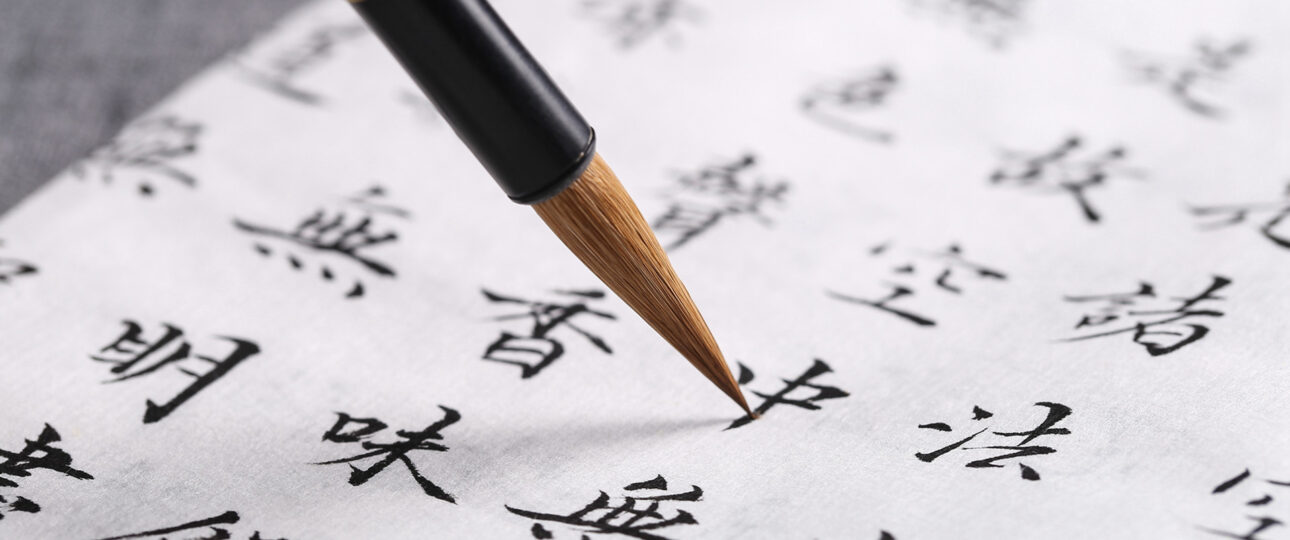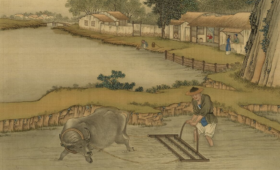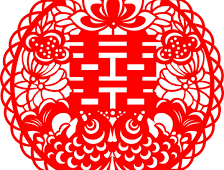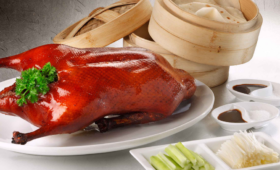Chinese calligraphy is the writing of Chinese characters as an art form,
combining purely visual art and interpretation of the literary meaning.
This type of expression has been widely practiced in China and has been generally held in high esteem across East Asia.
Calligraphy is considered one of the four most-sought skills and hobbies of ancient Chinese literati,
along with playing stringed musical instruments, the board game “Go”, and painting.
There are some general standardizations of the various styles of calligraphy in this tradition.
Chinese calligraphy and ink and wash painting are closely related:
they are accomplished using similar tools and techniques, and have a long history of shared artistry.
Distinguishing features of Chinese painting and calligraphy include an emphasis on motion charged with dynamic life.
According to Stanley-Baker, “Calligraphy is sheer life experienced through energy in motion that is registered as traces on silk or paper,
with time and rhythm in shifting space its main ingredients.
“Calligraphy has also led to the development of many forms of art in China,
including seal carving, ornate paperweights, and inkstones.
Characteristics
Chinese calligraphy appreciated more or only for its aesthetic quality has a long tradition,
and is today regarded as one of the arts in the countries where it is practised.
Chinese calligraphy focuses not only on methods of writing but also on cultivating one’s character and taught as a pursuit.
Chinese calligraphy used to be popular in China, Taiwan, Japan, and Korea.
In Taiwan, students were requested to write Chinese calligraphy starting from primary school all the way to junior high school on a weekly basis at least to the year 1980.
As young generations are “typing” more often than “writing”,
when PC, tablets and mobile phones became the major communication channels, Chinese calligraphy became purely art.
Materials and tools
The ink brush, ink, paper, and inkstone are essential implements of Chinese calligraphy. They are known together as the Four Treasures of the Study. In addition to these four tools, a water-dropper, desk pads and paperweights are also used by calligraphers.
Brush
Main article: Ink brush
A brush is the traditional writing instrument for Chinese calligraphy.
The body of the brush is commonly made from bamboo or other materials such as wood, porcelain,or horn.
The head of the brush is typically made from animal hair, such as weasel, rabbit, deer, goat, pig, tiger, wolf, etc.
There is also a tradition in both China and Japan of making a brush using the hair of a newborn child,
as a once-in-a-lifetime souvenir.
This practice is associated with the legend of an ancient Chinese scholar
who scored first in the imperial examinations by using such a personalized brush.
Calligraphy brushes are widely considered an extension of the calligrapher’s arm.
Today, calligraphy may also be done using a pen.
Paper
Paper is frequently sold together with a paperweight and desk pad.
Some people insist that Chinese calligraphy should use special papers,
such as Xuan paper, Maobian paper, Lianshi paper etc.
Any modern papers can be used for brush writing.
Because of the long-term uses,
Xuan paper became well known by most of Chinese calligraphers.
In China,Xuanzhi,traditionally made in Anhui province,is the preferred type of paper.
It is made from the Tatar wingceltis (Pteroceltis tatarianovii),as well as other materials including rice,
the paper mulberry (Broussonetia papyrifera), bamboo, hemp,etc.
Ink and inkstick
Ink is made from lampblack (soot) and binders,
and comes in inksticks which must be rubbed with water on an inkstone until the right consistency is achieved.
Much cheaper,pre-mixed bottled inks are now available,
but these are used primarily for practice as stick inks are considered higher quality and
chemical inks are more prone to bleeding over time, making them less suitable for use in hanging scrolls.
Learning to rub the ink is an essential part of calligraphy study.
Traditionally, Chinese calligraphy is written only in black ink,
but modern calligraphers sometimes use other colors.
Calligraphy teachers use a bright orange or red ink with which they write practice characters on which students trace, or to correct students’ work.
Inkstone
Commonly made from stone, ceramic, or clay,
an inkstone is used to grind the solid inkstick into liquid ink and to contain the ink once it is liquid.
Chinese inkstones are highly prized as art objects
and an extensive bibliography is dedicated to their history and appreciation, especially in China.
Seal and seal paste
Using seal paste with a Chinese seal
Main article: Chinese seal
Calligraphic works are usually completed by the calligrapher applying one or more seals in red ink.
The seal can serve the function of a signature.
Water calligraphy
Water calligraphy or ground calligraphy is a popular pastime in China.
The existence of temporary calligraphy, or water calligraphy, is also to be noted.
This is the practice of water-only calligraphy on the floor which dries out within minutes.
This practice is especially appreciated by the new generation of retired Chinese in public parks of China.
Ink wash painting
Calligraphy has influenced ink wash painting,
which is accomplished using similar tools and techniques.
Calligraphy has influenced most major art styles in East Asia,
including Ink wash painting, a style of Chinese, Japanese, and Korean painting based entirely on calligraphy.
Traditionally,the bulk of the study of calligraphy is composed of copying strictly exemplary works
from the apprentice’s master or from reputed calligraphers,
thus learning them by rote. The master showing the ‘right way’ to draw items,
which the apprentice have to copy strictly, continuously,
until the move becomes instinctive and the copy perfect.
Deviation from the model is seen as a failure.
Competency in a particular style often requires many years of practice.
Correct strokes, stroke order, character structure, balance, and rhythm are essential in calligraphy.
A student would also develop their skills in traditional Chinese arts,
as familiarity and ability in the arts contributes to their calligraphy.




